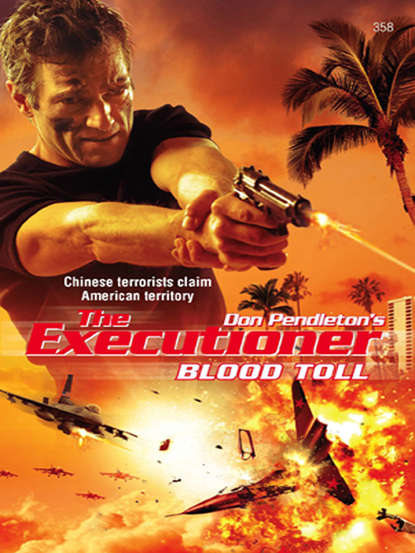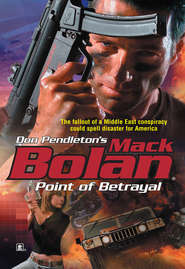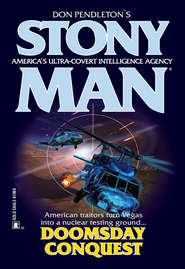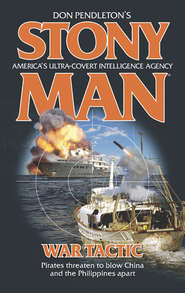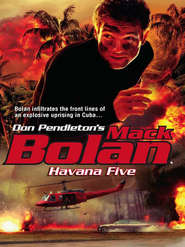По всем вопросам обращайтесь на: info@litportal.ru
(©) 2003-2024.
✖
Blood Toll
Автор
Год написания книги
2019
Настройки чтения
Размер шрифта
Высота строк
Поля
Diana Kirokawa called out to Bolan. She’d had to work her way around to the rear of the Charger to get a better angle on the NHL gunners. Now, as Bolan looked from his own position near the lead van, he saw that the two HPD officers were down and Bando was no longer in the cruiser. As Bolan watched, the big man ran into the flow of panicked drivers in the far right lane, narrowly missing being run down. Bolan held his fire; he would not be able to take the shot, not without risking hitting someone in a passing vehicle.
Bando jumped the concrete barrier on the other side and quickly disappeared.
One of the remaining NHL gunners leaned out too far from his position behind the second van. Kirokawa punched several holes through him with her Glock 19. Two of his comrades were already down, their blood spreading in pools across the pavement. But the NHL action had already provided Bando Kapalaua the diversion and time he needed to escape.
“Go! Go!” one of the gunmen shouted. The remaining NHL gunners began piling into the second van, which was already moving. Bolan left cover and emptied both of his guns into the rear of the fleeing vehicle, pocking the rear panel doors with holes and spidering the rear windows. Burning rubber, the big cargo van sped off, clipping a civilian vehicle trying to skirt the carnage.
Bolan ran to Kirokawa. He dropped the magazines in his pistols, reloading from the spares on his blacksuit under his windbreaker.
“Bando’s escaping,” Bolan informed her. “We’ve got to go.”
“We aren’t going anywhere.” Kirokawa shook her head. She nodded first to the remaining, bullet-scarred van, then to the police cruiser and the Charger. At least two tires on each vehicle were flat, shot through.
Bolan’s face darkened. There was nothing to be gained in cursing their luck. He moved cautiously around the side of the Malibu, taking in the scene.
Kirokawa followed, gasping when she saw what was left of Officers Davis and Charles. “I’ll call for an ambulance,” she said, pulling out her phone, her Glock still held in her right hand.
“Don’t bother,” Bolan said, kneeling beside the corpses. He checked first Charles, then Davis, just to be sure. “They’re gone.”
Kirokawa holstered her Glock. “Damn it all to hell!”
Bolan nodded slowly. Davis’s eyes were open in death. The Executioner, using his fingers, gently closed the man’s eyes. Before Bolan was finished in Hawaii, Bando Kapalaua would answer for his crimes and for these murders. This time, though, he would not answer to a revolving-door system of legal technicalities and soft-hearted judges.
This time, Bando Kapalaua would answer to the Executioner.
5
Hwong Zhi and his elite squad sat quietly as the Chevy Suburban carried them to their destination. The early-morning sun was already bright and hot. From behind the tinted side windows, Hwong watched the passing scenery. There were so many Americans and tourists going about their lives, oblivious to what was about to happen. The next day, or perhaps the one following, they would wake up in a world no longer dominated by the United States.
After so many years and so much preparation, it was hard to believe that the moment was finally here. He had long thought that when the moment did arrive, he would feel nervous or perhaps elated. He was forced to admit, however, that he felt nothing except the usual tension that came with executing a mission.
There was little of logistical value in their target. The raid, the first in the series of attacks that would commence the SST’s Honolulu operation, was largely symbolic in nature. It was designed to shake up the local authorities and create the sort of public panic that Hwong knew would facilitate the rest of the plan.
From a pocket of his ballistic-fabric load-bearing vest, Hwong removed a small transmitter device. This device was connected, through a wireless mesh network, to similar devices across the city, all carried by SST deep-cover sleepers. The devices were disguised as a variety of harmless everyday objects, most often pagers or cell phones. While of limited range on their own, each was a transceiver, capable of receiving and rebroadcasting encoded signals. Every one of these transceivers had limited range individually, but more than enough to reach the next nearest unit, which in turn retransmitted any signals sent on the encrypted frequencies. A chain was formed—a chain or web that blanketed the entire island and was impossible to pinpoint or even to jam easily. The devices were an outgrowth of the technology developed by the SST to jam and control local communications and data transfer.
Hwong regarded the device for a moment. Then he pressed his thumb against one of the buttons on its face.
Immediately, the devices carried by the elite squad began to vibrate, the buzzing faint but audible in the truck. As one, the six men under Hwong’s direct command turned to him, their faces impassive, their mood nevertheless expectant.
“We attack now,” Hwong said.
The doors of the Suburban swung open. Hwong and his team, wearing combat fatigues and boots, as well as load-bearing vests, fanned out from the vehicle, seeking targets of opportunity.
When the first targets were in range, they opened fire.
A family of four wearing bathing suits, the father carrying a plastic cooler on one shoulder, were the first to die.
Ala Moana Beach Park, acres of sand and recreational facilities, lay before the SST operatives, crawling with citizens enjoying the warm, sunny day. To Hwong, even at this distance, the water seemed impossibly blue, the beach altogether beautiful. He could appreciate beauty, he thought to himself. Executing his mission did not mean he could not recognize small wonders of that type. He was still thinking this when he targeted a fleeing woman, her long hair splaying out behind her as she fell to the sand a bloody, crumpled mess.
Somewhere behind Hwong, Wu’s heavy machine gun opened up, the rhythmic thunder of the weapon as pitiless as the sound of the waves lapping at the now bloody beach.
“Fan out,” Hwong ordered. “Sweep the beach. Fire at will.”
A large man in a bathing suit, his physique heavy with muscles, attempted to rush them from the side, perhaps thinking to tackle one of the men, maybe even wrestle a weapon away and turn it on the operatives. Hwong thought perhaps that was what he would do, were the situation reversed. The would-be hero got no closer than ten feet before a burst from Tsai’s UMP dropped him in his tracks. The .45-caliber rounds had made quick work of the poor fool, but still Tsai paused to fire another burst at the prone figure. The man was thorough; Hwong would grant him that.
The plan called for the team to sweep up the beach to a designated pickup point, where the driver of the Suburban would be waiting for them. It was not far; the purpose of the exercise was not to cover a great deal of ground, which would only expose them to possible counterattack. No, the purpose was to create as much death and fear as possible, violating this idyllic tourist spot and notifying the Americans that they were not safe, even in the “paradise” that was Hawaii.
When the authorities reacted to this seemingly pointless act of terrorism, it would destabilize them all the more when the SST’s Honolulu operation continued to roll on. Dealing with the aftermath of a terrible public shooting, they would be unprepared for a malicious incursion on their own soil, a choke hold that the SST’s sleeper cells had been planning for the better part of a decade.
IN HIS HOTEL ROOM, Mack Bolan sat on the edge of one of the twin beds. A quick shower and a few cups of coffee from the two-cup coffeemaker in his room eased his sore muscles and got him awake and functioning. Now he contemplated his latest care package from John “Cowboy” Kissinger, Stony Man Farm’s armorer and weaponsmith.
The Stony Man courier delivered the package late the previous evening at Bolan’s request for additional firepower. Kissinger had provided extra ammo, as well as explosives, including incendiary and conventional grenades, not to mention several remote-detonated plastic-explosive units. There was even a tactical folding knife, made by German-based Boker, which Bolan clipped to one of his pockets.
The centerpiece of Kissinger’s latest offering, however, was a modular FN SCAR-L, a light combat assault rifle chambered in 5.56 mm NATO rounds. Fed by Kissinger’s specially modified M-16 magazines, the weapon could fire 600 rounds per minute in full-auto. The fire group also had a semiautomatic mode, but no provision for burst fire. This version had a short barrel, an adjustable plastic stock, an Aimpoint optical sight and plastic forward grip, with a SureFire combat light and LaserMax laser sight mounted to its accessory rails.
Kissinger had included separately an FN EGLM 40 mm grenade launcher with ammunition. He had also sent a tactical harness, allowing Bolan to sling the weapon freely under his right shoulder. It was short enough that he could conceal it, somewhat awkwardly, beneath his three-quarter-length windbreaker, though the barrel would be exposed. It would do for the Executioner’s purposes, however.
Bolan placed the magazines and several grenades in his green canvas war bag. He would sling the bag over his shoulder after shrugging into the FN SCAR’s harness, covering the works with his windbreaker in an effort not to terrify any casual observers.
Bolan’s secure satellite phone began to vibrate. He flipped it open and put it to his ear. “Striker,” he said.
“Hey, Striker,” Barbara Price said. “How are you holding up?”
“All right,” Bolan said.
“No word on Kapalaua?” the Stony Man mission controller asked.
“No,” Bolan said. “HPD is working on it, but he’s gone to ground. He took down two of their own, so they’re highly motivated, but it’s clear Kapalaua’s not working alone. Somebody’s running him.”
“The Chinese, you mean.”
“If that’s who we’re dealing with. I was hoping you could fill in the blanks with the materials I couriered to you.”
“Bear has some information for you, in fact,” Price told him. “It’s fairly extensive. I’m transmitting a text file to your phone, but he’ll give you the highlights.”
“Thanks, Barb.”
“Watch your back, Striker,” Price said.
The connection was transferred to Kurtzman.
“Hey, big guy,” Kurtzman said. “You receiving the file?”
“Coming through now,” Bolan acknowledged.
“Here are the highlights. The numbers you found, which Jimmy Han must have uncovered after he penetrated Cheinjong, are a hexadecimal code. Specifically, the sample he transcribed corresponds to command and control codes. These are so new, I didn’t recognize them at first—it was Akira who spotted them.”
Akira Tokaido was the youngest member of the Farm’s cyberteam, an expert hacker in his own right.





